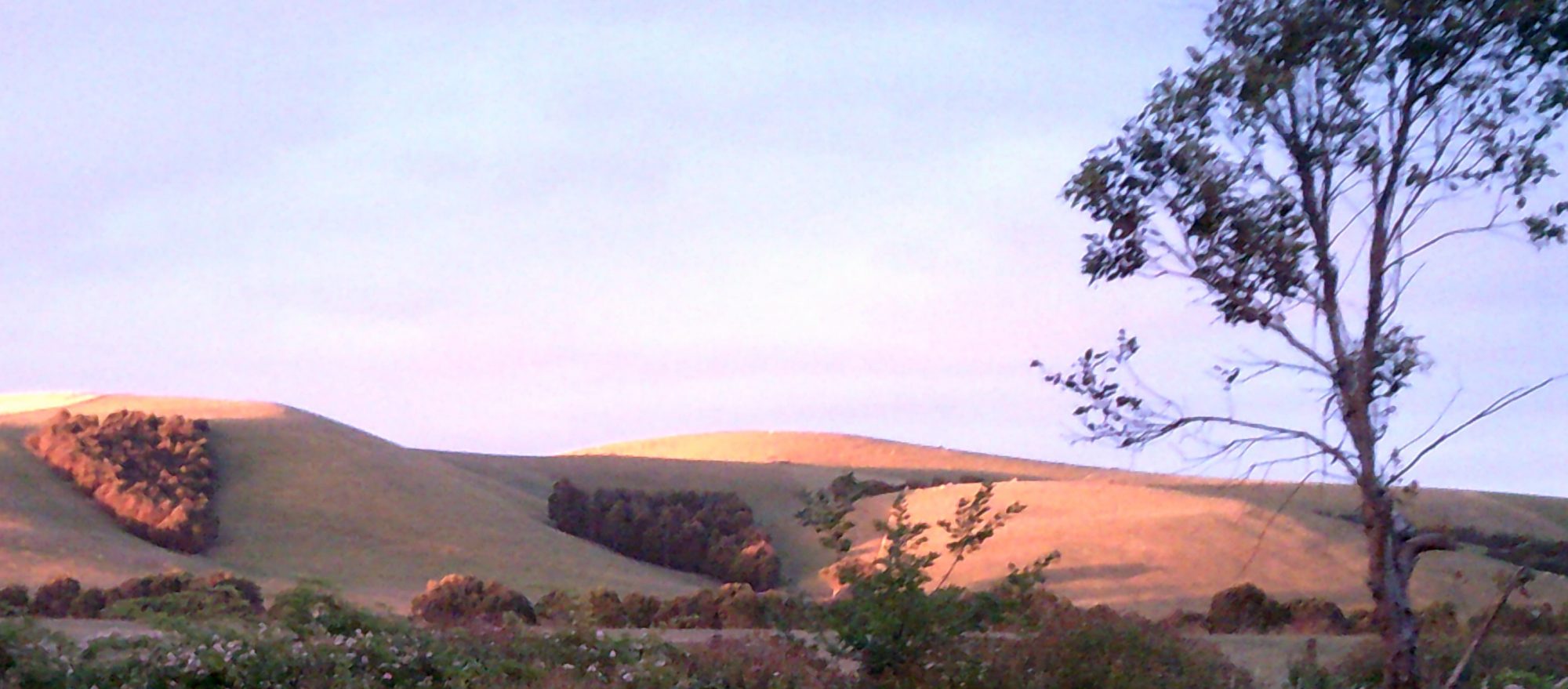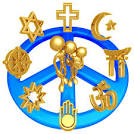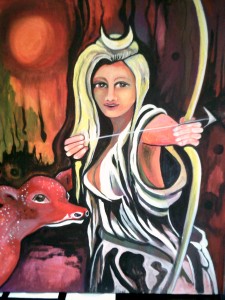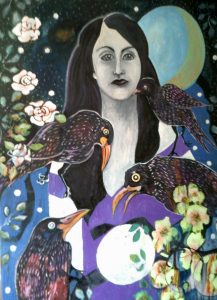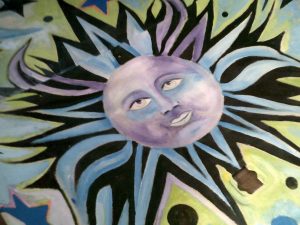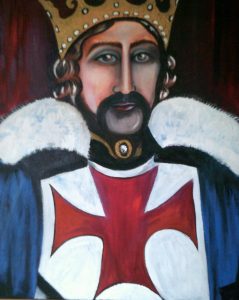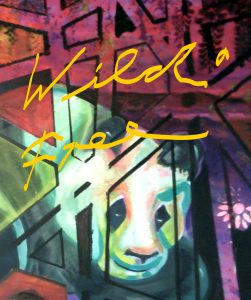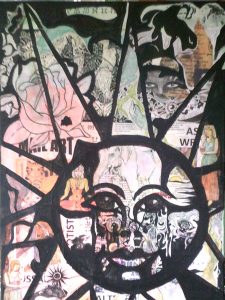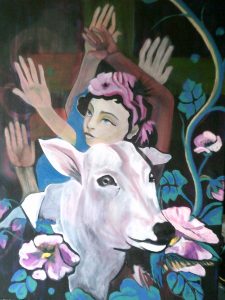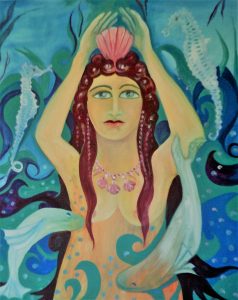
Canvey Island has a tradition of attracting rebels, witches, pirates, smugglers and social misfits. The island offered a discrete access to England via the mouth of the river Thames. The waters could be sand banked and treacherous with unpredictable cross currents that swallowed up everything in their path so it also gave protection to witches and Cunning Men (male witches). Many of the witches from further afield settled in the surrounding Essex villages. Some of the mystics came in the form of the Romany people who were itinerant workers that visited the island each year and parked their caravans on vacant lands. The women would sell poesies of flowers on the streets and tell fortunes, they had colourful clothes and gold teeth. They were also greatly feared because rumour had it that if you didn’t buy a poesy of flowers the seller would bestow upon your person the most deadly of a curses. There were numerous tales of people who had received curses, some had been left with excruciating pain, some just bad lunch and other had died in terrible accidents. Whether the curses worked on not seemed to be a matter of whether the individual believed they would work, hence they would act in ways that brought on their own fate. The Romany people travelled far and wide and they were very clever at reading the characteristics of people.
Strangely, I was always given a poesy of violets for free, I never knew why, but it did make me feel special. My mother and grandmother would often given the Romany people money, but without the need for flowers and my grandmother were very good at make her own poesies. Every Spring when the violets and lavender were in flower she would take a small paper lace doyly and fold it into a cone shape, then the bottom would be torn out so the stalks of the flowers would poke through and be held in place. The blooms were picked from our garden, there were hundreds of flowers including the narcissus and primroses that were used for medicines. Violets were my grandmother’s favourite flowers, she would dry them, eat them, dip them in hot sugar and make sweets of them. She would make her own perfumes and carry them with her to prevent sickness. Violets grew in abundance on the island along with the salt bush and heather.
I knew very little about the Island when I first moved there and I was too young to take much interest. Later I did gain some curiosity because some of the people living on the Island seemed very different to the city folks I had been familiar with. I stated to take more notice of my surroundings. I would walk a lot and survey the landscape, especially from the height of the sea wall which circled the Island to keep back the rising tides.
Canvey Island consisted of a small landmass at the mouth of the River Thames, it is just four miles long and three miles wide and several feet below sea level. The artist, whose house my family occupied, was one of many Dutch workers who had come to the island to dig ditches as protection against the rising flood waters. The entire area was marshland and sea water flooded the creeks at high tide. When compounded with bad weather the floods could be disastrous, spreading into neighbouring homes and causing dangerous rapids of mud and stones as the water churned up the compacted dirt roads. Canvey Island had a peculiar appeal. The Island was well known for its magical morning mists, its as well as for its old witches and crones, whose ghosts were said to dance on the graves of the ancestors and on the nights of the Solstice they would gather in the covens set in between the tall pine trees on the corner of the Long Road.
Canvey Island, or the land of Canaan, took its name from Biblical origins. The etymology is uncertain. An early explanation derives the term from the Semitic root knʿ to be low, humble, subjugated. Some scholars have suggested that this implies an original meaning of lowlands, in contrast with Aram, which would then mean highlands.[1] Purple cloth became a renowned Canaanite export commodity which is mentioned in the Exodus. The land of Cana was the name of a large and prosperous country which corresponds roughly to present-day Lebanon, Syria, Jordan and Israel and was also known as Phoenicia (a word meaning purple). At times Cana was independent, at others a tributary to Egypt. As child I had an inexplicable connection to the above-mentioned region. Perhaps it was because my uncles had served there during the Second World War. Perhaps it was the stories my grandmother told of the Arabian Knights. Western scholars have always argued that the Arabian Nights was a collection of fictional stories and part of an oral history that was largely embellished with myth. Biblical scholars had also called into question the historical accuracy of the Bible. I think I first hear of the word Cana at the Baptist Sunday School I went to when my mother decided to become a Christian. Her conversion did not last long enough to gain an extensive history of the Cana people. I did know the Canaan people were said to have lived in the City of Jerusalem. What was certain is that the Canaan people had something to do with the Crusades a topic that came to my attention through the paintings on the house walls and in particular the round white washed church in the landscape. I read somewhere that in 830 BCE: Hazael of Aram Damascus conquered most of Canaan, which set in motion a key cause of the Crusades. Was this a battle for religious supremacy or was there more?
The Knights Templar initially arrived in the Holy Land on a mission to reclaim some treasure that they believed was rightfully theirs. According to the modern Templar historians, Tim Wallace-Murphy and Christopher Knight, the knights who banded together as the Knights Templar were part of a wave of European royalty descended from Jewish Elders that had fled the Holy Land around 70 AD when it was invaded by the Romans. Before leaving their homeland, these Elders had hidden their temple treasures and priceless Essene and Kabbalistic scrolls in strategic regions of the Holy Land so that the Roman invader Titus could not plunder them as the spoils of war. The Jewish Elders then immigrated to Europe. There, many of them married into noble families. Of these Elders, twenty-four would become the patriarchs of a group of European families known by the sobriquet of the Rex Deus or Star families. These names would hold a particular meaning which would later be brought to my attention.
For hundreds of years the secret locations of the Jewish treasure filtered down through the families of the Elders. The First Crusade included knighted members of the Rex Deus who joined the procession of holy warriors travelling east with the dual goal of defeating the Moslems and recovering their family treasure.[2] The original nine Knights Templar were either born into or related to the Rex Deus families, as was Godfrey de Boullion, the French general who led them against the Saracens during the First Crusade. His cousin, King Baldwin II of Jerusalem, assisted the Templars in retrieving the treasure by donating the al-Aqsa Mosque for their use.
Canvey Island was sparse and underwhelming. As the writer Joseph Conrad commented the estuary of the Thames is not beautiful; it has no noble features, no romantic grandeur of aspect, of smiling geniality; but it is wide open, spacious, inviting, hospitable at first glance, with a strange air of mysteriousness which lingers about it to this very day.[3] Canvey Island is situated on the northern side of the River Thames and is approximately thirty miles from the City of London. The Island is four miles long and two miles wide and has a circumference of roughly 13 miles. It is separated from the mainland by a narrow creek which could be negotiated on foot at low tide. While most of Britain advanced commercially the island remained isolated due to its lack of access, but local farmers knew the value of good grazing wetlands and fiercely protected them. Vehicle access consisting of a bridge over the creek was built in 1931 and it changed the nature of the island considerably. A new railway on the mainland at Benfleet enabled people to commute to London and the population of the island grew, but flooding was a constant threat. For hundreds of years between the Roman occupation and the Anglo-Saxon settlement the island was believed to have been either wholly or partially submerged by the sea. Over time the island re-emerged, probably before the Norman Conquest, which may have appeared to some as if Canvey Island was the New Atlantis. It was during this was the period that the Anglo-Saxons named the island Cana’s people.
There has been wide dispute over the origins of the name Cana. Among Christians and other students of the New Testament, Cana is best known as the place where Jesus performed his first public miracle, the turning of a large quantity of water into wine at a wedding feast when the wine provided by the bridegroom had run out. [4] The other biblical references to Cana are also in the Fourth Gospel at John 4:46, which mentions that Jesus is visiting Cana when he is asked to heal the son of a royal official at Capernaum. Another reference appears in John 21:2, where it is mentioned that Nathanael (sometimes identified with the Bartholomew included in the synoptic gospels’ lists of apostles) comes from Cana. The Book of Joshua mentions one city (19:28) and one brook (16:8; 17:9) named Cana.
Archaeological history provides a more reliable thesis where Cana’s People were believed to descendants of both Cantiaci and the Catuvellauni. The Cantiaci or Cantii were a Neolithic Celtic people living in Britain before the Roman conquest, and they gave their name to a civitas group (civilians) of Roman Britain. They lived in the area now called Kent, in south-eastern England. Their capital was Durovernum Cantiacorum, now Canterbury.[5] Long before these groups existed it was believed that the Cana people were of Semitic origins and had migrated from Egypt and the surrounding kingdoms. Undoubtedly, trading ships from the coasts of Egypt and Palestine would have sailed across the Mediterranean as far as the coast of Britain. Shipbuilding was known to the Ancient Egyptians as early as 3000 BCE. The Archaeological Institute of America reported the earliest ship to be 75 feet long, and it may have possibly belonged to Pharaoh Aha. [6]
Much of the history pertaining to migration and early colonization has come to us through the investigations by language scholars who have discovered the links between the modern English language and the ancient language of the Hebrews of the Old Testament. The conclusion is that the beginning of the Egyptian captivity (1448 B.C.) and the Assyrian-Babylonian invasions (745-586 B.C.) saw the Biblical Israelites first settled on the shores of Britain.
One of the 19th centuries’ most famous language experts was James Cowles Pritchard, who lived from 1786 to 1848. Pritchard was known as the founder of modern anthropology. In his Eastern Origin of the Celtic Nations (1857), he tells us that there is an analogy between the Hebrew-Semitic languages and the Celtic (Keltic).[7] Pritchard traces the Celtic language and finds links between the Indo-European and the Semitic language, which he believes may have been language in a state of transition. Pritchard, who spells Celt with a K, tells an interesting story demonstrating the connection between Hebrew and Celtic people. He states: From another I have learned that a crew of Bretons (i.e., Kelts) understood the natives of Tunis (in North Africa). How? Because the Kelt tongues were so like the Hebrew, and the Carthaginian was the same. To be clear, Prichard notes how a ship from the British Isles had stopped in port in North Africa, in modern Libya, and the crew members were surprised to be able to understand the natives who spoke Carthaginian, a Hebrew dialect. [8]
Pritchard summarizes his finding by saying, … even cautious investigators have not only given a list of Semitic elements in the Keltic, but have made the Keltic especially Semitic. A common language is prima facie evidence in favour of a common lineage … Language is one of those signs of community of origin which is slow to be abolished – slower than most others. Pritchard believes that the Celts arrived in Britain from Asia, and suggests two routes were used to travel westward to the isles: First, from Asia across Northern Africa and by sea to Britain; second, west from Asia and the Caucasus to Europe. [9] He goes on to say: With the Irish … writer upon writer asserted for them an origin from Egypt, Persia, Palestine, or Phoenicia – especially from Phoenicia… The Phoenicians were what the Hebrews were, and the Hebrews were what is called Semitic… the Hebrew language… and the Keltic tongues… practiced the initial permutation of letters in their grammatical formations… Then there were certain habits and superstitions among the Kelts, which put the comparative mythologist in mind of certain things Semitic; the Bel-tane, or midsummer-day fire of the Highlands of Scotland got compared with fire-worship of the Phoenician Baal. Then there were the words Bearla Fena, or language of Fene of the Irish annals… well translated by Lingus Pena, or Linge Punica – the language of Phoenicia.”[10]
The highly distinguished language scholar, William H. Worrell, Associate Professor of Semitics at the University of Michigan, proved that the Celtic language evolved in some way from both the Hebrew and Egyptian languages. In his 1927 book, A Study of Races in the Ancient Near East[11], he states: In the British Isles certain syntactic phenomena of insular Celtic speech have led to the inference that in this region languages were spoken which had some relation, however remote, to the Hamitic-Semitic family… the Insular Celtic languages, particularly colloquial Welsh, show certain peculiarities unparalleled in Aryan languages, and these remind one strongly of Hamitic and Semitic. Dr. Worrell shows that the structure of the Hebrew, Egyptian, and Celtic languages is related. He goes on to say, …we find that the Celtic languages of the British Isles, particularly in their spoken forms, differ from all other Aryan languages, and in a way to suggest the Hamitic or Semitic tongues…
How could the Celtic people exhibit language characteristics in common with both Hebrew and Egyptian? The eminent scholar theorizes that the ancestors of the Celts, before coming to the British Isles, had dwelt for a time in North Africa near Egypt, where they came into contact through trade with both the Hebrews and Egyptians. However, occasional trading would not change the entire structure of their language! A much greater intimacy with both the Hebrews and Egyptians is indicated. Would it not make more sense that the ancestors of the Celts were themselves Hebrews who escaped from Egyptian bondage westward? The Israelites were in an extended captivity in Egypt and thus would have had a solid mixture of both languages in their vocabulary, exactly as, the Celts had. Dr. Worrell comments on the ancient Hebrews. We fancy we can almost follow them across into Europe, and imagine them the builders of Stonehenge and the dolmens of Brittany. Perhaps they were the people of Druidism. It may be that Caesar’s soldiers heard in Aquitania (France) the last echoes of European Hamitic speech; and that Goidels and Brythons learned from Pictish mothers the idioms of this pre-Aryan British tongue. And may not this have been, indeed, the language of the whole Mediterranean race? Many years of scholarship, and many pages of evidence, prove that Dr. Worrell was correct. [12]
The Danish scholar, Dr. Louis Hjelmslev, in his book Language: An Introduction (1970) pointed out the great influence of the Semitic language upon the Indo-European languages.[13] He states: Even a language like Greek, which is considered one of the purest Indo-European languages and which plays a greater role than any other in comparative Indo-European studies, contains only a relatively small number of words that can be genetically accounted for on the basis of Indo-European. Dr. Hjelmslev argued that most European words are borrowings from non-Indo-European languages. In fact, a genetic relationship between Indo-European and Hamito-Semitic (i.e., Egyptian-Hebrew) was demonstrated in detail by the Danish linguist Hermann Möller, using the method of element functions. [14]
Further, the similarity between Hebrew and English goes far beyond the mere resemblance of similar sounding words. The element-functions represent a genetic relationship between English and both Hebrew and Egyptian. These languages are therefore related in their very root structure, showing a common origin. Given these facts, a group of Danish language scholars proposed eliminating the separate language categories of Semitic and Indo-European, combining them into one new category called, Nostratic, a name proposed by Holger Pedersen for the languages related to our own, namely Hamito (Egyptian) and Semitic (Hebrew). The word, nostratic, is taken from the Latin word, nostras, meaning, our own countrymen. In other words, the Semites are our own countrymen, because both language streams indicate a common origin in their very root structure. [15]
The theory that Indo-European and Semitic sprang from a common origin has often been suggested and rejected. The first scholar equipped with exact knowledge of both fields to undertake its defence was H. Möller (1906). His argument rests upon a series of phonetic laws which describe the variations of the two main branches from the assumed parent language. On the Indo-European side Möller starts with the hypothetical forms that all Indo-European scholars use (though with varying views as to their value). For the other term of the comparison, however, he has to construct for himself a prehistoric Semitic.[16]
Dr. Terry Blodgett, chairman of the Southern Utah State College Language Department, received international attention in 1982 as a result of his research, which discovered a major Hebrew influence in the roots of the English language. A newspaper report commented: Recent discoveries concerning the Germanic languages suggest there must have been extensive Hebrew influence in Europe, especially in England, Holland, Scandinavia and Germany during the last seven centuries of the pre-Christian era (700 B.C. to Christ). These dates take us back to the conquest and the missing ten tribes of Israel, who were moved out of Palestine by Assyria and dispersed to other lands between 845 and 676 B.C.
Dr. Blodgett’s doctoral dissertation was on Similarities in Germanic and Hebrew deals with the latest linguistic discoveries, which he states have traced various tribes of Israel into Europe. Dr. Blodgett presented his research in seminars in America, Germany, and Switzerland during the 1980’s.
Another scholar, Dr. Isaac Elchanan Mozeson from Yeshiva University completed ten years of research into this subject and gives over 5,000 English words with a Semitic origin. His conclusion was, that English and Hebrew are profoundly connected. His findings show that, many more words should be acknowledged as borrowings from the Hebrew. Some of these giant oversights include ogre (from mighty Og, king of Bashan) and colossus (a Greek version of the Hebrew Gollius, familiar to English speakers as Goliath).[17] Do some words sound alike in Hebrew and English? He says, There are hundreds of’English and Hebrew words that sound remarkably alike and mean the same but are not cited by linguists. A few of these are abash and boosha, albino and labhan, evil and avel, lick and lakak, regular and rageel, and direction and derech. Further evidence of a connection exists in word meanings. He tells us that: Many names of animals only have meanings in Hebrew. Giraffe means ‘neck’and skunk means ‘stink’ in Semitic speech. A few additional examples from Dr. Mozeson’s scholarly encyclopedia of the Hebrew origin of English words was published in 1989.
The research of other scholars also substantiates this evidence. For example, famed Celtic scholar, John Rhys, in The Welsh People, speaks of convincing evidence of the presence of some element other than Celtic… We allude to an important group of Irish names formed much in the same way as Hebrew names are represented in the Old Testament. [18] Many of these scholars further assert that the Celtic ancestors of the modern English people spoke a language with a structure that was strongly influenced by both Hebrew and Egyptian. Yet, only the ancient Israelites of the Bible, fresh from hundreds of years of Egyptian captivity, would exhibit such a unique language style.
Historians have often written about the Phoenician ships that sailed the Mediterranean Sea to Britain in early times, but few relate the connection between the Hebrew and Phoenician languages. The Bible Handbook by Dr. Joseph Angus, D.D., states: The Hebrew language was the common tongue of Canaan and Phoenicia.[19] In Ancient Hebrew Sea Migrations, they show that a significant portion of the so-called Phoenician trade was in reality Israelite. [20]
The land of Canaan was a similar shape to Canvey Island, the difference was size, Canaan was three hundred miles long and fifty miles wide, making Canvey Island a mere dot on the landscape. Canaan was the land which Moses and Joshua called the Promised Land, the place where Moses took the Jewish people after they fled Egypt. Canaan ran south of the Dead Sea and up to the southern parts of the country which are now Lebanon. The inhabitants of this land were known as Canaanites and their territory was made up of a series of city states that closely resembled the Greek states. The more prosperous Canaanites who occupied the northerly Mediterranean coast were also known as the Phoenicians which meant land of palm trees, purple country or purple people. In total the area included the coastline of what is now Lebanon, Israel, Gaza, Syria, and south-west Turkey, and some of its colonies later reached the Western Mediterranean, most notably Carthage and even as far as the Atlantic Ocean. The civilization spread across the Mediterranean between 1500 BC and 300 BC. Phoenicia is an Ancient Greek term used to refer to the major export of the region, cloth dyed Tyrian purple from the Murex mollusc, and referred to the major Canaanite port towns.[21] Around 1050 BC, a Phoenician alphabet was used for the writing. [22] It became one of the most widely used writing systems and was used by the Phoenician merchants across the Mediterranean world, where it evolved and was assimilated by many other cultures.
The Canaanite culture appeared to develop from or beside the earlier Ghassulian chalcolithic culture. Ghassulian itself developed from the Circum–Arabian Nomadic Pastoral Complex, which in turn developed from a fusion of their ancestral Natufian and Harifian cultures with Pre–Pottery Neolithic B (PPNB) farming cultures, practicing the domestication of animals, during the 6200 BC climatic crisis which led to the Neolithic Revolution in the Levant. [23] Byblos is revealed as an archaeological site from the Early Bronze Age. The Late Bronze Age state of Ugarit is considered quintessentially Canaanite archaeologically, [24] even though the Ugaritic language does not belong to the Canaanite languages proper. [25] Phoenician societies had three power-bases that consisted of the king, the temples and their priests as well as the councils of elders. Byblos first became the predominant centre from where the Phoenicians dominated the Mediterranean and Erythraean (Red) Sea routes. It was here that the first inscription in the Phoenician alphabet was found, on the sarcophagus of Ahiram (c. 1200 BC). In The Perspective of the World Fernand Braudel noted that Phoenicia was an early example of a world-economy and it was surrounded by empires. The high point of Phoenician culture was located in its sea power, which is usually placed around c. 1200–800 BC. A concentration in Phoenicia silver date between 1200 and 800 BC, however, this also contains hacksilver with lead isotope ratios matching ores in Sardinia and Spain.[26] This metallic evidence agrees with the biblical memory of a western Mediterranean Tarshish that supplied Solomon with silver via Phoenicia, during the latter’s heyday. [27]
There are numerous Biblical references in Samuel 5:11 state: And Hiram king of Tyre sent messengers to David, and cedar trees, and carpenters, and masons: and they built David a house. The building of the temple was a pivotal point in the history of the Canaanites, the Templars and the Freemasons.
Ezra 3:7: They gave money also unto the masons, and to the carpenters; and meat, and drink, and oil, unto them of Zidon, and to them of Tyre, to bring cedar trees from Lebanon to the sea of Joppa, according to the grant that they had of Cyrus king of Persia. Also in Chronicles 2:14 we find, The son of a woman of the daughters of Dan, and his father [was] a man of Tyre, skilful to work in gold, and in silver, in brass, in iron, in stone, and in timber, in purple, in blue, and in fine linen, and in crimson; also to grave any manner of graving, and to find out every device which shall be put to him, with thy cunning men, and with the cunning men of my lord David thy father. The term cunning man is the name given to a male witch and was commonly used during the witch hunts of Europe, in particular those areas surrounding Canvey Island.
In 1 Kings 7:14 – He [was] a widow’s son of the tribe of Naphtali, and his father [was] a man of Tyre, a worker in brass: and he was filled with wisdom, and understanding, and cunning to work all works in brass. And he came to king Solomon, and wrought all his work.
The religious practices and beliefs of Phoenicia were cognate generally to their neighbours in Canaan, which in turn shared characteristics common throughout the ancient Semitic world. Canaanite religion was more of a public institution than of an individual experience. Its rites were primarily for city-state purposes; payment of taxes by citizens was considered in the category of religious sacrifices. Unfortunately, much of the Phoenician sacred writings known to the ancients have been lost. [28] The Phoenicians were known for being very religious. Canaanite religion included temple prostitution and child sacrifice. Tophets built to burn their sons and their daughters in the fire are condemned by God in Jeremiah 7:30-32, and in 2nd Kings 23:10 (also 17:17). Notwithstanding these and other important differences, cultural religious similarities between the ancient Hebrews and the Phoenicians persisted.
In Canaan the supreme god was called El, which means god in common Semitic. The storm god was Baal, meaning master. Other gods were called by royal titles, as in Melqart meaning king of the city, or Adonis for lord . On the other hand, the Phoenicians, notorious for being secretive in business, might use these non-descript words as cover for the hidden name of their god, a name known only to a select few initiated into the inner most circle. or not even used just as their neighbours the ancient Hebrews used the word Adonai (Heb: Lord ) to place a cover over the name of their God. [29]
That the pagan gods found their role in the healing of body and mind is alluded to clear in the New Testament. Luke 6:17 – And he came down with them, and stood in the plain, and the company of his disciples, and a great multitude of people out of all Judaea and Jerusalem, and from the sea coast of Tyre and Sidon, which came to hear him, and to be healed of their diseases. This was the practice of witches and shaman.
The Semitic Phoenician religious landscape is made of numerous differences between cities whereby urban pantheons also shared some common characteristics especially in the organization of deities as triads. These did not exclude the presence of other less important gods they just elevated the most useful ones. The collection of gods was diverse, but due to the leading role of the city-state of Tyre, its reigning god Melqart was prominent throughout Phoenicia and overseas. Melqart was often titled Ba’l Ṣūr, Lord of Tyre , and considered to be the ancestor of the Tyrian royal family. In Greek, by interpretatio graeca he was identified with Heracles and referred to as the Tyrian Herakles. According to Josephus records (Antiquities 8.5.3), following Menander the historian, concerning King Hiram I of Tyre (c. 965–935 BCE): He also went and cut down materials of timber out of the mountain called Lebanon, for the roof of temples; and when he had pulled down the ancient temples, he both built the temple of Heracles and that of `Ashtart; and he was the first to celebrate the awakening (egersis) of Heracles in the month Peritius.
The gods Baal, Astarte and Melqart symbolized the triad in Tyre. Melqart was the tutelary power of the city, his name means “king of the city”. His cult dates back to the tenth century BC when Hiram, King of Tyre, had established a sanctuary in honour of the god, and spread his veneration. Melqart is considered as the founder of the city and the protector of its economic activities. Due to the presence of a strong component of Tyre with the Phoenician expansion in the Mediterranean, the cult of Melqart was exported all over the known world: from Gibraltar to Cyprus, and through North Africa, the Italian islands, the Aegean islands… He had a pivotal role in relations between metropolis Tyre, and its colony Carthage. Each year, during a festivity (known as the Egeris by Greek authors), Tyrians and Carthaginians celebrated together in Tyre the resurrection of the god Melqart, which was another expression of the “god who dies and reborn”. The Astarte of Tyre has the same qualifiers as its Sidonian neighbour: the goddess of love and fertility. Aside from these two central figures (Melqart and Astarte), the Tyre pantheon is a series of varied divine entities such as: Shamem Baal (Lord of Heaven), Baal Shaphon (master of winds and ocean currents), and Baal Malage (Lord of sailors).[30] Baal means god.
Astarte or Ashtoreth is the Hellenized form of the Middle Eastern goddess Ishtar, worshipped from the Bronze Age through classical antiquity. The name is particularly associated with her worship in the ancient Levant among the Canaanites and Phoenicians. Ishtar was the Mesopotamian goddess of love, beauty, sex, desire, fertility, war, combat, and political power, the East Semitic (Akkadian, Assyrian, and Babylonian) counterpart to the Sumerian Inanna, and a cognate of the Northwest Semitic goddess Astarte and the Armenian goddess Astghik. Ishtar was an important deity in Mesopotamian religion from around 3500 BCE, until its gradual decline between the 1st and 5th centuries CE with the spread of Christianity.
Ishtar’s primary symbols were the lion and the eight-pointed star of Ishtar. She was associated with the planet Venus and subsumed many important aspects of her character and her cult from the earlier Sumerian goddess Inanna. Ishtar’s most famous myth is the story of her descent into the underworld, which is largely based on an older, more elaborate Sumerian version involving Inanna.
In the standard Akkadian version of the Epic of Gilgamesh, Ishtar is portrayed as a spoiled and hot-headed femme fatale who demands Gilgamesh become her consort. When he refuses, she unleashes the Bull of Heaven, resulting in the death of Enkidu. This stands in sharp contrast with Inanna’s radically different portrayal in the earlier Sumerian epic of Gilgamesh, Enkidu, and the Netherworld. Ishtar also appears in the Hittite creation myth and in the Neo-Assyrian Birth Legend of Sargon.
Although various publications have claimed that Ishtar’s name is the root behind the modern English word Easter, this has been rejected by reputable scholars, and such etymologies are not listed in standard reference works. She is also known as Venus in her role as Roman goddess. She was the goddess of love, beauty, desire, sex, fertility, prosperity and victory. In Roman mythology, she was the mother of the Roman people through her son, Aeneas, who survived the fall of Troy and fled to Italy. Julius Caesar claimed her as his ancestor. Venus was central to many religious festivals, and was revered in Roman religion under numerous cult titles.
The Romans adapted the myths and iconography of her Greek counterpart Aphrodite for Roman art and Latin literature. In the later classical tradition of the West, Venus becomes one of the most widely referenced deities of Greco-Roman mythology as the embodiment of love and sexuality.
In myth, Venus-Aphrodite was born of sea-foam. Roman theology presents Venus as the yielding, watery female principle, essential to the generation and balance of life. Her male counterparts in the Roman pantheon, Vulcan and Mars, are active and fiery. Venus absorbs and tempers the male essence, uniting the opposites of male and female in mutual affection. She is essentially assimilative and benign, and embraces several otherwise quite disparate functions. She can give military victory, sexual success, good fortune and prosperity. In one context, she is a goddess of prostitutes; in another, she turns the hearts of men and women from sexual vice to virtue. [31]
[1] Bible Places: The Topography of the Holy Land, Henry Baker Tristram, 1884 and Wikipedia.
[2] The Origin of the Knights Templar – Descendants of Jewish Elders …
www.ancient-origins.net/…/origin-knights-templar-descendants-jewish-elders-005078
[3] Basil E. Cracknell. PhD. Canvey Island. The history of a marshland community University Press Leicester.
[4] The Holy Bible. King James version. John 2:1–11
[5] https://en.wikipedia.org/wiki/Cantiaci
[6] https://en.wikipedia.org/wiki/Ancient_Egyptian_trade
[7] James Cowles Prichard Eastern Origin of the Celtic Nations (1857),
Kessinger Publishing, and 1 Mar. 2003 p108.
[8] Ibid p108.
[9] Ibid p380.
[10] Ibid p75.
[11] William H. Worrell, Associate Professor of Semitics at the University of Michigan, proved that the Celtic language evolved in some way from both the Hebrew and Egyptian languages. In his 1927 book, A Study of Races in the Ancient Near East pp 40 -50.
[12] Ibid
[13] Dr. Louis Hjelmslev Language: An Introduction (University of Wisconsin Press, 1970)
[14] Ibid.
[15] Dr. Louis Hjelmslev, in his book Language: An Introduction (University of Wisconsin Press, 1970),pp63-80
[16] H. Möller in his book Semitisch und Indogermanisch, I Konsonanten (Kopenhagen and Leipzig, 1906).
[17] Dr. Isaac Elchanan Mozeson
[18] John Rhys, in The Welsh People, p66
[19] The Bible Handbook by Dr. Joseph Angus, D.D.,p13. and Ancient Hebrew Sea Migrations
[20] http://www.british-israel.ca/Hebrew.htm
[21] https://en.wikipedia.org/wiki/Phoenicia
[22] Naveh, Joseph (1987), “Proto-Canaanite, Archaic Greek, and the Script of the Aramaic Text on the Tell Fakhariyah Statue”, in Miller; et al., Ancient Israelite Religion. Coulmas (1996).
[23] Zarins, Juris (1992), “Pastoral nomadism in Arabia: ethnoarchaeology and the archaeological record—a case study” in O. Bar-Yosef and A. Khazanov, eds. “Pastoralism in the Levant”
[24] Tubb, Jonathan N. (1998), “Canaanites” (British Museum People of the Past)
[25] Woodard, Roger (2008), The Ancient Languages of Syria-Palestine and Arabia
[26] Chamorro, Javier G. (1987). “Survey of Archaeological Research on Tartessos”. American Journal of Archeology. 91 (2). JSTOR 505217.
[27] Thompson, C.; Skaggs, S. (2013). “King Solomon’s Silver? Southern Phoenician Hacksilber Hoards and the Location of Tarshish”. Internet Archaeology. 35 (35). doi:10.11141/ia.35.6.
[28] Gaster, Theodor H. (1965). “The Religion of the Canaanites”. In Ferm, Vergilius. Ancient Religions. New York City: Citadel Pres (original ed.: Philosophical Library 1950).pp13-45.
[29] Brandon (1970), p. 655 (“YHVH“), p. 173 (“Canaanite Religion”). Brandon, S.G.F., ed. (1970). Dictionary of Comparative Religion. New York City: Charles Scribner’s Son.
[30] http://www.pheniciens.com/articles/religion.php?lang=en
[31] Staples, Ariadne, From Good Goddess to vestal virgins: sex and category in Roman religion, Routledge, 1998, pp. 12, 15-16, 24 – 26, 149 – 150: Varro‘s theology identifies Venus with water as an aspect of the female principle. To generate life, the watery matrix of the womb requires the virile warmth of fire. To sustain life, water and fire must be balanced; excess of either one, or their mutual antagonism, are unproductive or destructive.
